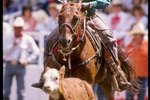
There are as many opinions on breaking a yearling as there are methods of doing so. A yearling is a horse who has turned one year old. Breaking -- while it sounds awful -- actually refers training a horse that culminates in the horse accepting a human on his back. Typically this occurs when a horse is young.
Yearling Growth Considerations
Your yearling is not physically mature, and won’t be until his growth plates -- spaces between bones separated by cartilage -- close, or fuse. This occurs throughout his life, culminating at age four and with some horses, longer. He has numerous growth plates throughout his body. It's not necessary to wait until all growth plates fuse prior to breaking your horse for riding, but consult your vet about his ability to safely support a rider’s weight, which also varies by breed. Warmbloods, for example, grow more slowly than other breeds. You also risk damaging your horse’s back by starting too early.
The First Months
Handling your young horse is the first step toward breaking him, and some people start within minutes of birth. Handling a newborn minutes after birth and gradually getting him used to events that will occur in his life, such as shots, having his teeth checked and other medical examinations is called imprinting. You don’t have to follow the imprinting method exactly -- just perform a few basics. For example, put a halter on him early and then practice taking it off and putting it back on; stroke his ears, lips, gums and teeth; and pick up his feet.
Response to Pressure
Teaching your yearling to properly respond to pressure is the first step to leading him, tying him and riding him. If he fights pressure and restraint, he can hurt himself and you. If you attach a lead rope to his halter and pull, he won’t understand your command. Get a long lead rope and wrap it around his hindquarters, pulling the free end to ease him forward. When he moves, relax your hand. He'll learn that moving forward or standing still releases pressure. Don’t tie your horse until he understands the concept of giving in to pressure, as he could fight and damage his neck or flip over.
Preparing to Ride
With a long lead rope or lunge line, teach your horse to walk, trot, canter and halt in response to verbal commands. Put a bridle and bit in his mouth, gently lifting each rein so he understands the pull of the bit. Place a bareback pad with girth on him, then transition to a saddle. Put a weight in the saddle like a sack of grain, holding it so it doesn’t fall. When your yearling accepts this, lean your body over the saddle and rub your hands all over him. Now, when your horse is physically ready, he is prepared to accept your full weight in the saddle.
References
- EquiSearch: Training Yearlings
- Dressage-Connection.com: The Correct Age and Way to Break a Young Horse – An Interview with German Top Trainer Uwe Schwanz
- Horsetopia: What is Horse Breaking?
- Extreme Mustang Makeover
- Four Corners Equine Rescue: Bone Growth
- Robert M. Miller Communications: Imprint Training – An Overview
Resources
Photo Credits
-
David De Lossy/Photodisc/Getty Images
Writer Bio
Based in Central Texas, Karen S. Johnson is a marketing professional with more than 30 years' experience and specializes in business and equestrian topics. Her articles have appeared in several trade and business publications such as the Houston Chronicle. Johnson also co-authored a series of communications publications for the U.S. Agency for International Development. She holds a Bachelor of Science in speech from UT-Austin.



